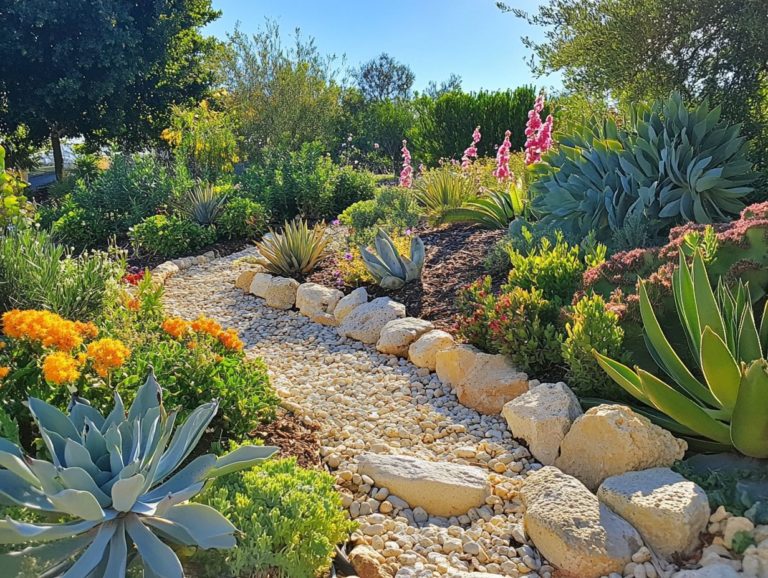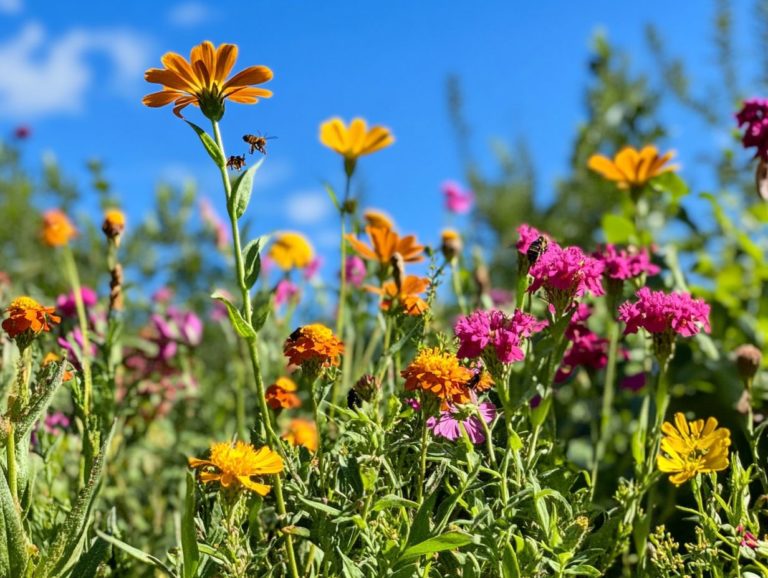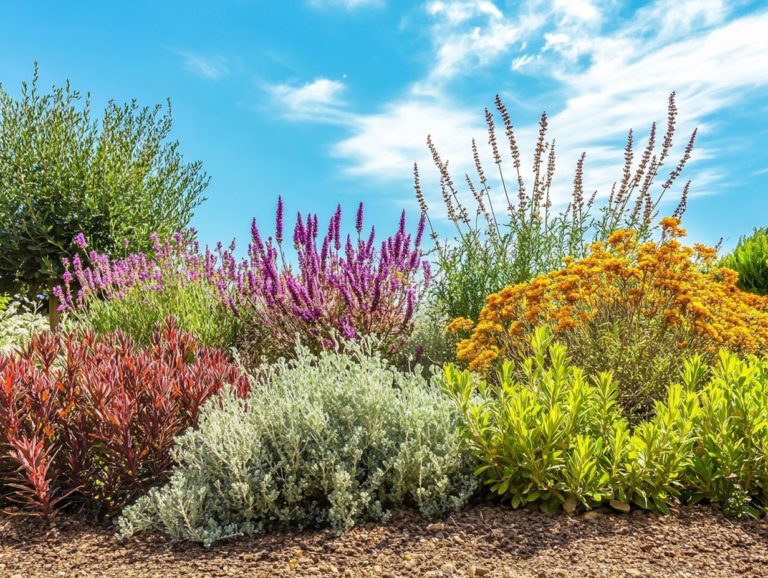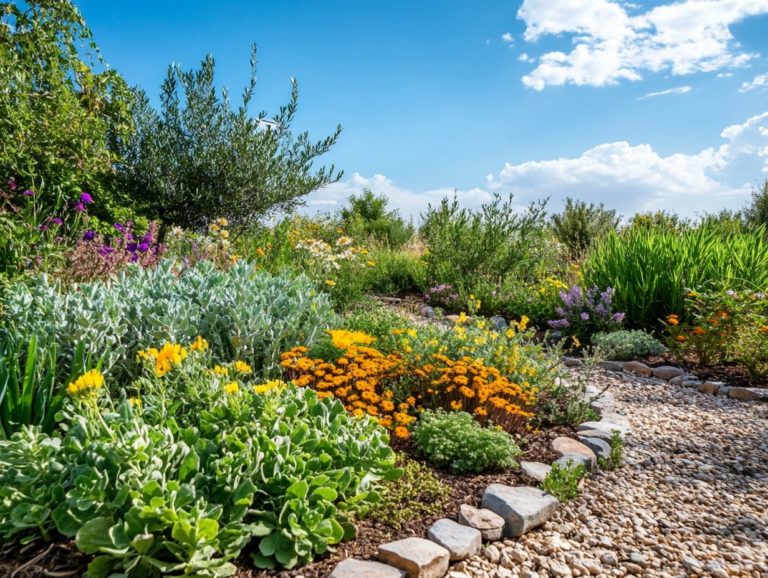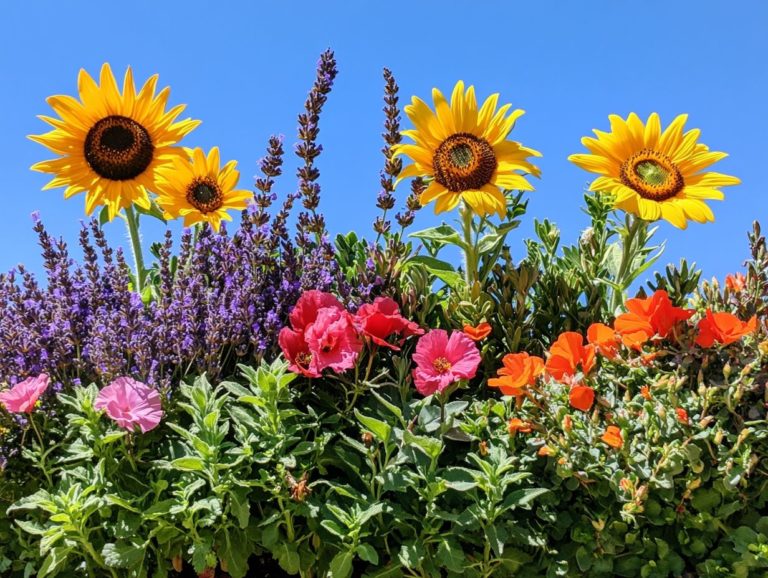The Benefits of Rain Gardens in Drought Areas
Rain gardens offer a great solution for managing stormwater and improving environmental health, especially in areas prone to drought. These innovative landscapes not only enhance the beauty of your surroundings but also conserve water and support local ecosystems.
Let s explore what rain gardens are, their benefits in water-scarce regions, and a step-by-step guide for creating and maintaining one. Discover how selecting the right plants can strengthen your garden s resilience and positively impact your community’s water systems.
Contents
- Key Takeaways:
- Understanding Rain Gardens
- The Role of Rain Gardens in Drought Areas
- Creating a Rain Garden
- Choosing the Right Plants for a Rain Garden
- Maintaining a Rain Garden
- Community Benefits of Rain Gardens
- Frequently Asked Questions
- How do rain gardens benefit drought areas?
- What are the environmental benefits of rain gardens in drought areas?
- Do rain gardens require a lot of maintenance?
- Can rain gardens be used in both residential and commercial areas?
- How can rain gardens help save money in drought areas?
- Are there any additional benefits of rain gardens in drought areas?
Key Takeaways:
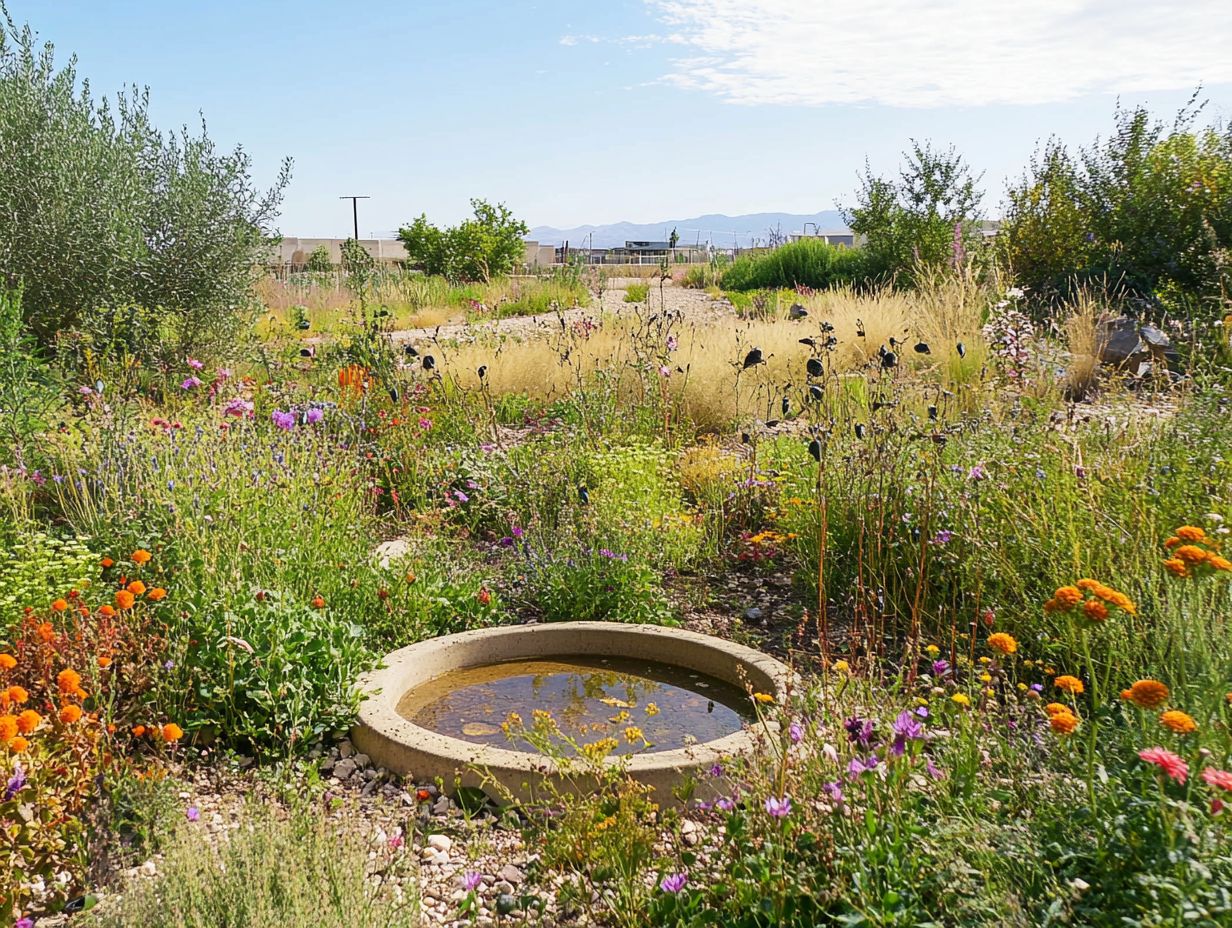
- Rain gardens are a simple and effective way to conserve water in drought-prone areas, providing both environmental and community benefits.
- By choosing the right plants and following maintenance tips, rain gardens can help reduce water usage and support native plant species in their natural habitat.
- Rain gardens also have a positive impact on local water systems, making them a valuable asset to any community.
Understanding Rain Gardens
Understanding rain gardens is crucial in today s urban environment, as climate change reshapes our water management strategies. These sustainable gardening solutions function as special gardens designed to absorb rainwater, reduce flood risks, and enhance water quality.
By incorporating native plants, rain gardens not only help recharge groundwater but also promote ecosystem health. Additionally, using rain barrels for drought gardening offers a dual benefit that makes them invaluable in raising community awareness and supporting environmental education initiatives.
What are Rain Gardens?
Rain gardens are carefully designed landscapes that manage stormwater runoff and improve the quality of local water. They typically consist of native plants and specially formulated soil, allowing for effective absorption and filtration of excess rainwater.
By capturing stormwater, rain gardens significantly reduce flooding and erosion while filtering out harmful pollutants like heavy metals and nutrients. This natural filtration process alleviates adverse effects on local waterways and helps restore groundwater balance.
For homeowners, adopting rain gardens is a cost-effective way to enhance drainage systems and minimize the need for expensive plumbing upgrades.
The Role of Rain Gardens in Drought Areas
In regions prone to drought, rain gardens serve as vital tools for water conservation. They act as natural irrigation systems, promoting groundwater recharge and supporting the importance of community gardens in drought areas.
By integrating these gardens into your landscape, you contribute to a more resilient ecosystem that conserves precious water resources.
How Rain Gardens Help Conserve Water
Rain gardens play a vital role in water conservation by enhancing soil filtration and maximizing water absorption during rainfall. These thoughtfully designed green spaces capture excess rainwater, allowing it to seep into the ground, which reduces stormwater runoff.
The soil in a rain garden typically features a curated mix of sand, silt, clay, and organic matter, all working together to improve drainage and encourage deep infiltration. As water filters through this unique blend, pollutants are naturally removed, ensuring cleaner water replenishes the groundwater supply.
By fostering these natural processes, rain gardens not only alleviate flooding but also help replenish local aquifers, contributing to a healthier ecosystem overall.
Benefits for the Environment
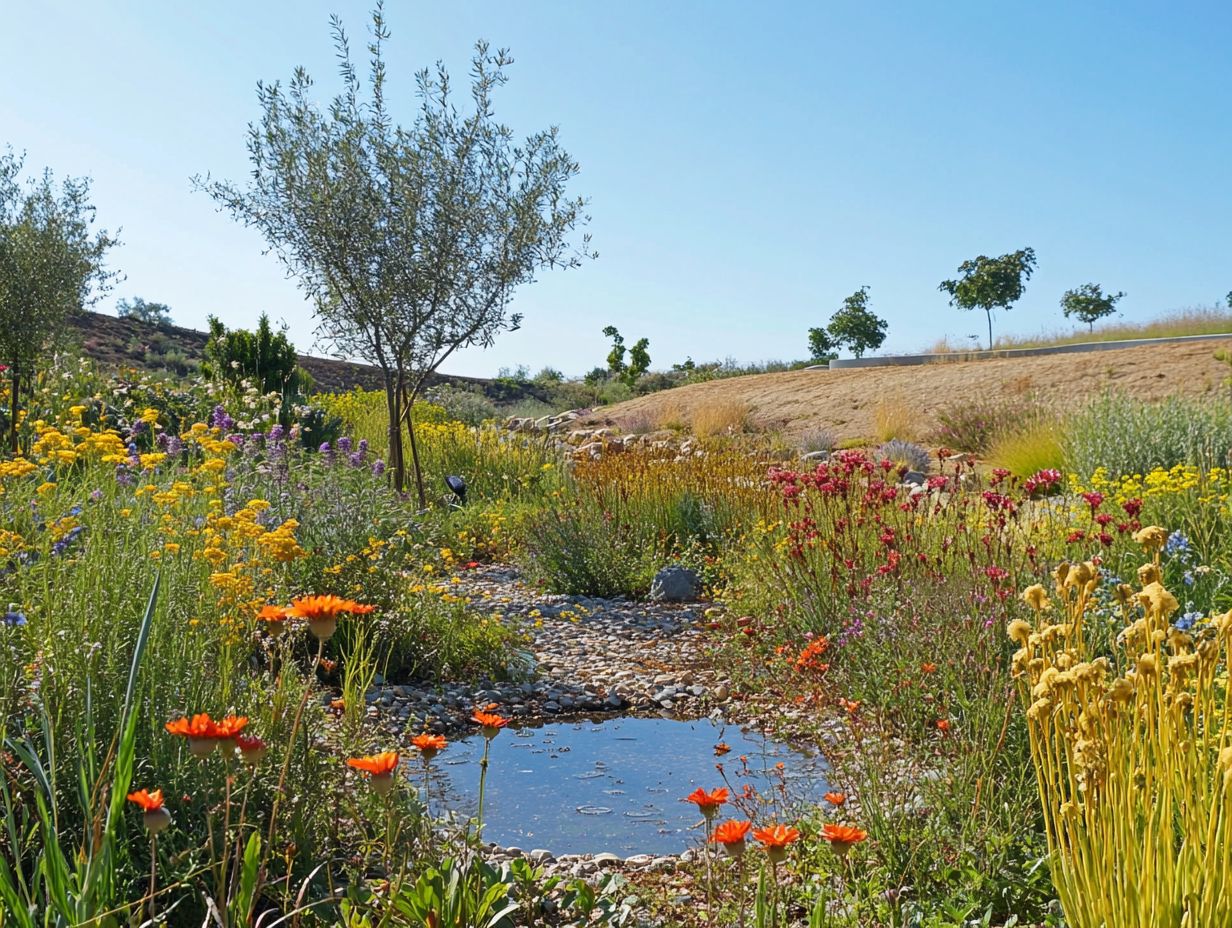
Rain gardens provide numerous environmental benefits. These include effective stormwater management, wildlife shelter, and habitat protection, all of which contribute to the overall health of the ecosystem. Additionally, exploring the long-term benefits of drought gardening can further enhance your gardening practices.
These vibrant green spaces capture and filter rainwater, significantly reducing runoff and helping to prevent potential flooding in urban areas. By allowing water to soak into the ground, they aid in recharging local aquifers, or natural underground water sources, ensuring a healthier water supply for the community.
Rain gardens create essential habitats for many species, attracting beneficial insects, birds, and pollinators. This supports biodiversity and encourages the growth of local flora. The diverse array of plants in these gardens enriches the soil and fosters a balanced ecosystem, enhancing the environment’s resilience to climate change.
Creating a Rain Garden
Creating a rain garden requires a series of deliberate steps that elevate both function and aesthetics.
- Begin by carefully selecting the ideal location, ensuring it captures and absorbs rainwater efficiently.
- Next, enhance your drainage systems to optimize water flow.
- Implement planting strategies that are thoughtfully tailored to your local conditions, ensuring a thriving ecosystem that benefits both your garden and the environment.
Step-by-Step Guide
Creating a rain garden is a rewarding endeavor! Follow this clear step-by-step guide: assess your site, choose suitable native plants, and ensure proper drainage for an aesthetically pleasing outdoor space.
- Start with a thorough evaluation of your chosen location, paying close attention to factors like sunlight exposure and soil type, as these elements are pivotal for success.
- Next, when you select native plants, you’re enhancing the beauty of your garden and nurturing local biodiversity, creating a thriving habitat for pollinators and beneficial insects.
Once your garden is established, regular care is essential! Water your garden during dry spells and weed it periodically to keep those plants healthy and vibrant. By implementing these thoughtful landscaping techniques, you ll ensure that your rain garden effectively manages stormwater runoff while serving as a stunning visual feature in your outdoor landscape.
Choosing the Right Plants for a Rain Garden
Selecting the right plants for your rain garden is essential for achieving drought resistance, fostering biodiversity, and creating a welcoming habitat for pollinators.
Native Plants and Drought Resistance
Native plants shine in rain gardens, thanks to their remarkable drought resistance and ability to adapt to local soil conditions, which offer substantial environmental benefits. For more insights, explore the benefits of drought-resistant gardening.
These plants flourish in their specific local environments, developing deep root systems that stabilize the soil and enhance its structure. This leads to improved soil health by preventing erosion and promoting water retention.
Moreover, native flora attracts a diverse array of wildlife, from essential pollinators like bees and butterflies to various bird species, fostering a balanced ecosystem.
Their innate capacity to filter pollutants and excess nutrients from stormwater runoff further emphasizes the importance of rain gardens in addressing water quality challenges. By cultivating a vibrant habitat, these plants not only enhance the beauty of landscapes but also play a pivotal role in ecological sustainability.
Maintaining a Rain Garden
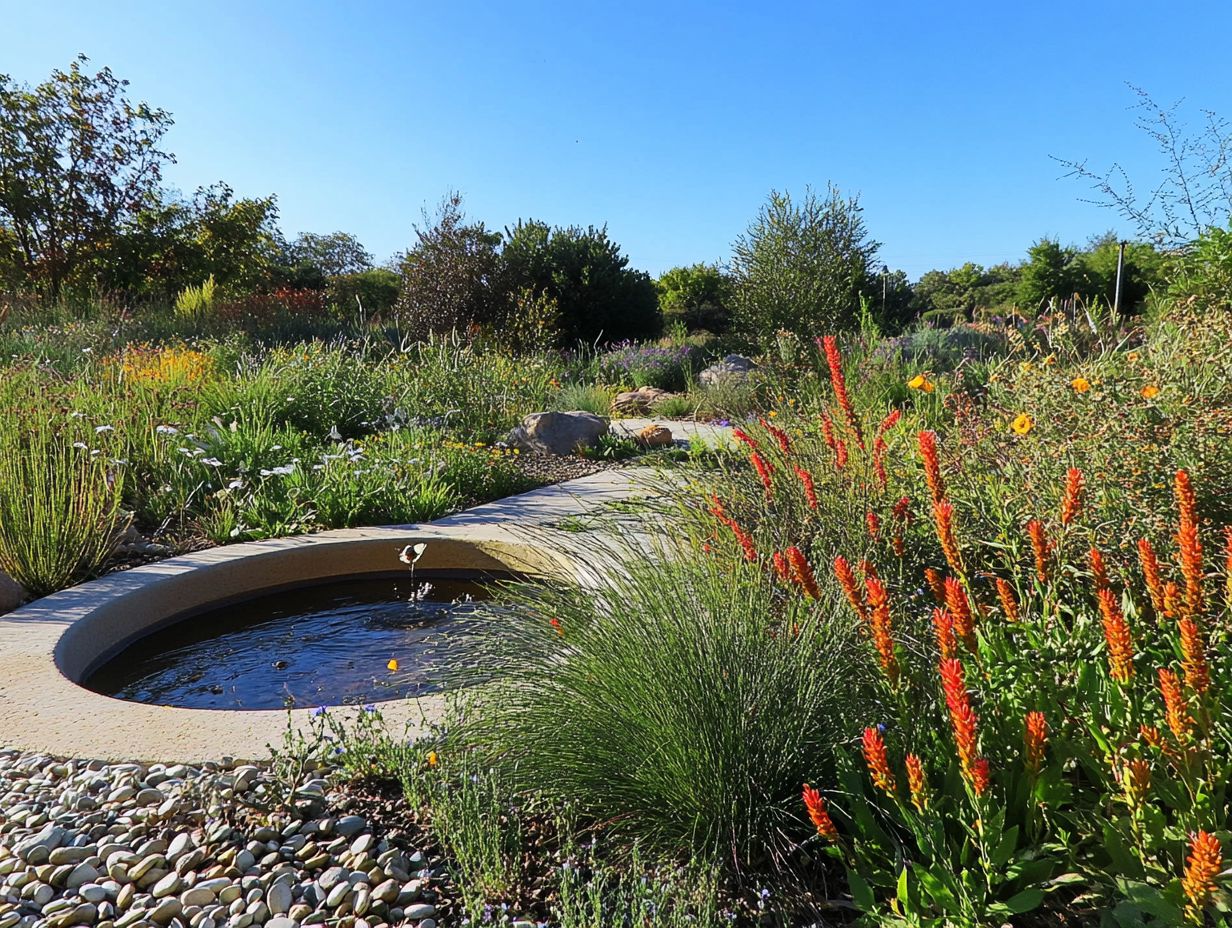
To maintain a rain garden, regular care is essential! Ensure that its ecological benefits and aesthetic appeal stay vibrant and impactful over time.
Tips for Keeping a Healthy Rain Garden
Maintaining a healthy rain garden involves thoughtful practices, such as regularly monitoring for pollutants and ensuring it serves as a sanctuary for local wildlife.
In addition to these foundational steps, it s crucial to routinely check for any debris or sediment buildup that could hinder proper drainage. Seasonal care should be a top priority, especially following heavy rains or storms, as these events can unveil new growth or even invasive plants that require your attention.
By planting a diverse array of native species, you enhance the garden’s aesthetic appeal while providing essential food and shelter for local wildlife. Keeping an eye on the health of these plants is vital for maintaining balance within the ecosystem, making it a welcoming habitat for beneficial insects and birds that play important roles in pollination and pest control.
Community Benefits of Rain Gardens
The community advantages of rain gardens extend well beyond individual properties, playing a significant role in enhancing local water systems and nurturing environmental education initiatives, including the health benefits of gardening with drought plants.
Impact on Local Water Systems
Rain gardens actively improve local water systems by enhancing rainwater management, contributing to flood control, and aiding in pollution control measures.
These beautifully landscaped areas capture and absorb runoff from impervious surfaces like roads and rooftops, effectively filtering out pollutants such as sediments and nutrients before they reach nearby waterways. By mimicking nature s processes, rain gardens create habitats for local wildlife while significantly reducing the risk of flooding during heavy rainfall events.
These gardens recharge groundwater levels, promote biodiversity, and nurture healthier ecosystems. When communities incorporate rain gardens into their urban planning, they can experience tangible improvements in their resilience against stormwater challenges, showcasing the vital role these green infrastructures play in developing sustainable cities.
Frequently Asked Questions
How do rain gardens benefit drought areas?
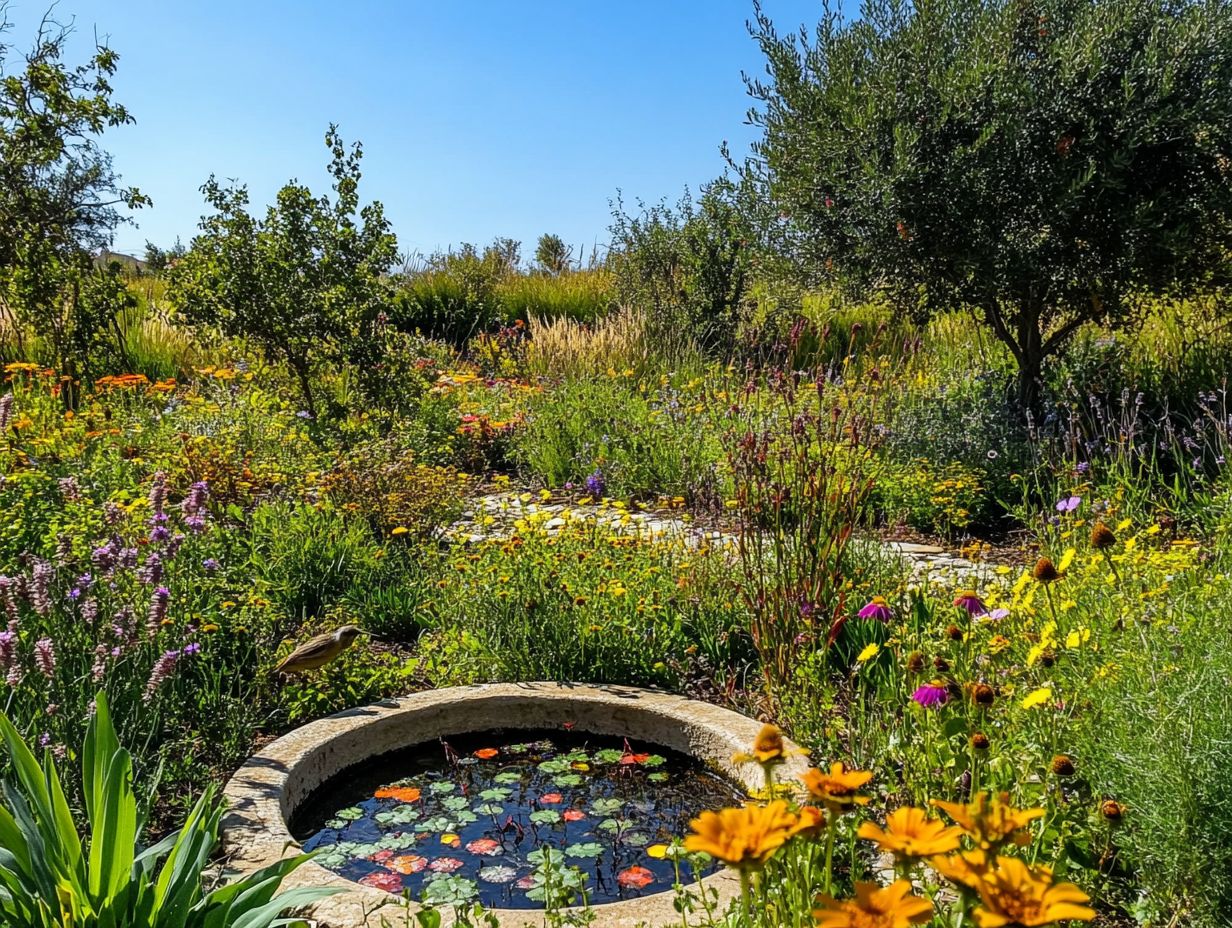
Rain gardens provide a natural solution for managing water during drought periods. They capture and store rainwater, reducing the strain on local water supplies, and can help transform your garden for better drought resilience.
What are the environmental benefits of rain gardens in drought areas?
Rain gardens help reduce erosion, filter pollutants, and promote healthy soil and plant growth. They also provide habitats for beneficial insects and birds.
Do rain gardens require a lot of maintenance?
While they do require some maintenance, rain gardens are designed to be low-maintenance. Once established, they typically only need occasional weeding and pruning.
Can rain gardens be used in both residential and commercial areas?
Yes, rain gardens can be implemented in both residential and commercial areas. They can be customized to fit the available space and bring various benefits to both types of properties.
How can rain gardens help save money in drought areas?
By capturing and storing rainwater, rain gardens reduce the need for expensive irrigation systems and water usage, leading to significant cost savings for homeowners and businesses.
Are there any additional benefits of rain gardens in drought areas?
In addition to their environmental and economic benefits, rain gardens can also highlight the long-term benefits of drought gardening, enhancing the aesthetic appeal of an area and providing a beautiful and natural landscape for people to enjoy.
Consider creating your own rain garden or participating in community initiatives related to them. Together, we can enhance our environment while enjoying the benefits of these beautiful landscapes.

